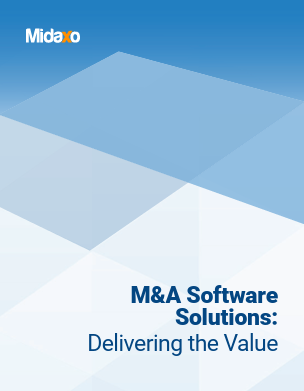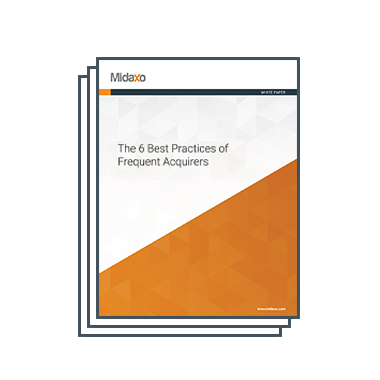Undoubtedly, leveraging M&A activity can bring unprecedented value to companies. More specifically, frequent buyers (sometimes referred to as serial acquirers) — no matter their size — increase company value faster than infrequent acquirers. However, simply entering the M&A arena does not guarantee value creation — especially in the competitive post COVID-19 marketplace. In fact, it is only with proper M&A strategy and robust processes that M&A deals generate true value.
One of the key best practices for serial acquirers is the utilization of M&A pipeline management software. Many acquirers are still living in the days of generic tools like Excel, SharePoint, and Teams — ultimately slowing down workflows, opening themselves up to mistakes or possible security breaches, and missing out on powerful analytics and reporting that significantly contribute to successful deals. The conclusion is clear: if frequent acquirers are going to succeed in modern times by acting quickly, confidently, and securely, adopting an M&A pipeline management platform is non-negotiable.
M&A Challenges Associated With Using Generic Tools
Before we delve into the specific benefits and value creation opportunities related to M&A pipeline software, it is important to identify and understand the specific challenges related to using generic and disjointed tools. Current M&A practitioners highlight the following as pitfalls related to using traditional tools for M&A:
- Inability to easily track where targets are in the pipeline – Managing M&A pipeline in Excel is “clunky” at best.
- Lack of a single source of truth – No centralized place for collaboration when files and data and documents are stored on individual PCs and/or laptops.
- Disorganized and unruly communication and workflows – Managing hundreds of messages in email (and the higher likelihood of missing something of critical importance or hitting roadblocks).
- Difficulty reporting on target/deal progress – It’s harder to maintain transparency and report to executives and the board of directors.
- Increased employee burnout and deal fatigue, putting the deal at risk.
Why You Need M&A Pipeline Software
Ability to easily manage a multitude of targets and identify “best fit” targets
Managing potential targets and all CRM-related communication can be tracked in one place, making it easier and more efficient to build relationships with potential targets. Moreover, one of the most impactful benefits of M&A pipeline software is the ability to establish and input criteria related to your company’s M&A goals and then to score targets against these criteria. Decisions on which targets to pursue are now backed and informed by specific data. Users are also able to get real-time updates on target scoring, and the criteria can be easily changed if your deal strategy shifts.
The benefit to frequent acquirers
Streamlined communication and organized, data-driven target scoring allows frequent acquirers to keep their pipeline active even when multiple deals are taking place. It also works to ensure they are focusing on the right targets for their specific goals and needs. Detailed target scoring significantly reduces the danger of wasted efforts on improper targets that actually do not portend successful deal results and value creation.
Heightened collaboration that is both secure and efficient
Centralized work allows for more robust collaboration and alignment of multifunctional teams throughout the M&A process. This translates to increased efficiency, and, potentially, to a reduction in human error and/ or duplicate work. When files are not in a centralized location, such as an M&A platform or in M&A software, not only are practitioners opening themselves up to errors and wasted time by working off of old versions of Word or Excel documents, but also transparency is non-existent. Potential back-ups and problems cannot be anticipated because there is no single source of truth. Teams cannot effectively manage their work and leaders cannot have true oversight. Everyday components of doing business, such as working with people in different time zones or key players being out sick, can become major roadblocks when work is not centralized and cannot be easily picked up by another person or updated in real time.
At their best, M&A platforms should improve secure collaboration. In fact, cybersecurity throughout the M&A process is becoming more and more critical given increased cyberthreats. Again, one repository for all deal communication and documents aids security, while customized permissions such as role-based privileges keep documents safely on the screens of only those who need them. Additional secure collaboration features include two-factor authentication, 24/7 monitoring, audit logs, and customer data security.
The benefit to frequent acquirers
When you are doing multiple deals a year, time is quite literally of the essence—you need to move quickly on each target and opportunity. This work must be automatic and workflows must be efficient. Utilizing M&A software enables frequent acquirers to evaluate targets and close deals faster than using traditional, standalone tools. Similarly, the more companies you interact with, the greater potential for security breaches, making secure, centralized collaboration all the more critical and valuable.
In the same vein, your collaboration and improved work streams must be safe and secure to protect the integrity of both you—the acquirer—and the target, as well deal value. Each separate tool or device someone on the M&A team uses brings with it the opportunity for a security breach, which at best will slow the deal down. And at worst it could kill the deal and tarnish your company’s reputation. Studies confirm cloud based M&A platforms are more secure and better able to respond to security challenges than standalone tools.
Robust reporting and analytics
The best M&A pipeline management platforms provide key metrics and analytics, such as active pipeline by stage, region, or quarter as well as deal scoring. This reporting at the beginning of the pipeline eliminates hours of traditional M&A leg work, allowing for more acquisitions, while simultaneously increasing the odds of a successful deal that will actually produce value. M&A platforms also enable reporting related to task and team progress, plus deal progress correlated to your company’s overall M&A strategy. Clear, concise, and visually appealing real-time reports provide another benefit: keeping executives and board members up to date.
Of course, robust reporting and analytics are essential throughout the deal’s lifecycle, such as during due diligence and post-merger integration. Post close, these metrics can help buyers determine if they were able to take advantage of all synergies and if the deal lived up to its predicted value.
The benefit to frequent acquirers
The benefits of reporting and analytics are plentiful. Moving between deals and targets is made easier with pipeline software. The best pipeline software allows users to easily toggle between multiple deals and targets and view the status of tasks.
Reporting features and analytics allow frequent acquirers to stay focused on their overarching M&A strategy, from deal sourcing and evaluation to integration. Moreover, they free up time team members would have spent producing charts, graphs, presentations, and other reports using standalone, generic tools. Multiply this loss of time focused on deal value by the number of active deals and/or targets moving through the pipeline, and the cumulative amount of wasted time and lost productivity is huge.
Cultivation of M&A process and living playbooks
Employing M&A deal platforms and software also lends itself to the creation of consistency and the cultivation of company-wide M&A best practices. For instance, acquirers can develop deal checklists with standard tasks and deal milestones.
When evaluating M&A pipeline software it is important to choose software designed by those with true M&A experience, as that experience permeates the platform and its functions, benefiting you, the practitioner.
Finally, M&A software makes completing retrospectives faster and easier post close for acquirers, enabling them to continue to hone M&A best practices. This retrospective element is critical for serial acquirers as it allows them to assess what practices were instrumental in contributing to past deal success, and what practices may need to be tweaked to assure maximum value creation in the future.
Why this is especially important for frequent acquirers
M&A pipeline software keeps dealmakers [or practitioners] focused on the deal versus the process, saving significant time since deal playbooks and ideal target profile criteria are clearly and easily stored and acted upon.
Additionally, as your deal volume increases, more often than not, the need to pivot will arise. Having a standardized, robust process in place makes handling unexpected changes much easier. M&A pipeline software empowers serial acquirers to better manage their pipelines while offering avenues for flexibility if market or company dynamics change and impact overall M&A strategy.
Final Thoughts / Conclusion
Dedication to your M&A practice—especially if that practice involves frequent acquisitions—must include adoption of a robust M&A pipeline software. Historical reliance on Excel or other disjointed tools for your M&A endeavors simply does not provide the complete package of best practice processes that will assure the most successful deal outcomes.
Building an M&A engine that can support multiple deals a year requires agility — the ability to pivot at a moment’s notice and to analyze many targets in parallel. In order to evaluate quickly, purpose-built pipeline management software is especially vital. A single source of truth with workflows based on your predefined value creation strategy immediately lays bare any issues and identifies clear points of alignment. Additionally, improved transparency across teams and streamlined processes ensure stronger, value producing deals that can be moved forward in nearly half the time.
Acting quickly, confidently, and securely has become both a necessity and the norm for any frequent acquirer — M&A pipeline management software will set you up for success. Learn more about pipeline management best practices. Download our Dealflow & Pipeline Management Guide here.





